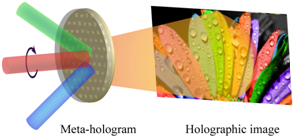Full-color 3D Meta-holography with 40 Times Increased Viewing Angle
Holography technology provides a promising way to design and reconstruct electromagnetic waves with desired phases and amplitudes, which has a broad range of applications in beam shaping, in authentication, and in the entertainment industry. The large pixel size and the limited phase modulation ability of the traditional holograms, however, usually limited the performance of the holography, e.g., the limited viewing angle and the 3D full-color imaging ability. Prof. Xiangang LUO from the State Key Laboratory of Optical Technologies on Nano-fabrication and Micro-engineering (SKLOTNM), Institute of Optics and Electronics, Chinese Academy of Sciences, and Prof. Minghui HONG’s team from Department of Electrical and Computer Engineering, National University of Singapore have now demonstrated that full-color 3D meta-holography imaging with extended viewing angles can be realized by a single layer of nanostructured metallic surface. The results published on Nov. 5 in Science Advances which was founded by the American Association for the Advancement of Science (AAAS).

Figure 1: An illustration of full-color meta-holography. (Credit: SKLOTNM, Chinese Academy of Science)
The meta-hologram is constructed by nano-rectangular holes in a 75-nm-thick chromium film. The phase modulation within the entire visible color range is fully controlled by spatially adjusting the orientation angle of the nano-rectangular holes, due to the intrinsic achromatic feature of the structure. The minimum pixel size of the hologram is only 200×200 nm2, which is much smaller than the wavelength of visible light. So the viewing angle of the holographic projection can be larger than ± 90 degrees, i.e., imaging in whole half space. Compared with the spatial light modulators which have typical pixel sizes of at least 8×8μm2, the viewing angle of their meta-hologram for the holographic projection can be 40 times or more extended. In order to overcome the cross-talk among different colors, that normally exists in current metasurface holography, they introduced an off-axis illumination method to shift the holographic image in different colors and successfully reconstructed all visible colors in the imaging area. This method not only leads to a remarkable image quality, with a signal-to-noise ratio (SNR) five times better than those of the previous meta-hologram designs, but also paves the way to create new meta-hologram devices.

Figure 2: Seven-color meta-holographic image of the Sun Phoenix, a pattern discovered on an ancient artifact gold coil, made in the Chinese Shang dynasty 3000 years ago. (Credit: SKLOTNM, Chinese Academy of Science)
To illustrate their reconstructed holographic images, they made a colorful flower with three primary colorillumination by red, green and blue laser light.Seven![]() -color meta-holography and multicolor 3D imaging were also demonstrated. This work has a potential in broad applications extending of holography, e.g., data storage, security, and authentication.
-color meta-holography and multicolor 3D imaging were also demonstrated. This work has a potential in broad applications extending of holography, e.g., data storage, security, and authentication.
Contact:
Prof. Xiangang LUO
E-mail: lxg@ioe.ac.cn
State Key Laboratory of Optical Technologies on Nano-fabrication and Micro-engineering (SKLOTNM), Institute of Optics and Electronics,Chinese Academy of Sciences
